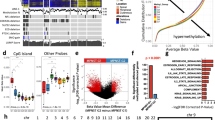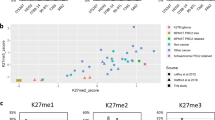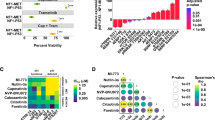Abstract
Malignant peripheral nerve sheath tumors (MPNSTs) represent a group of highly aggressive soft-tissue sarcomas that may occur sporadically, in association with neurofibromatosis type I (NF1 associated) or after radiotherapy1,2,3. Using comprehensive genomic approaches, we identified loss-of-function somatic alterations of the Polycomb repressive complex 2 (PRC2) components (EED or SUZ12) in 92% of sporadic, 70% of NF1-associated and 90% of radiotherapy-associated MPNSTs. MPNSTs with PRC2 loss showed complete loss of trimethylation at lysine 27 of histone H3 (H3K27me3) and aberrant transcriptional activation of multiple PRC2-repressed homeobox master regulators and their regulated developmental pathways. Introduction of the lost PRC2 component in a PRC2-deficient MPNST cell line restored H3K27me3 levels and decreased cell growth. Additionally, we identified frequent somatic alterations of CDKN2A (81% of all MPNSTs) and NF1 (72% of non-NF1-associated MPNSTs), both of which significantly co-occur with PRC2 alterations. The highly recurrent and specific inactivation of PRC2 components, NF1 and CDKN2A highlights their critical and potentially cooperative roles in MPNST pathogenesis.
This is a preview of subscription content, access via your institution
Access options
Subscribe to this journal
Receive 12 print issues and online access
$209.00 per year
only $17.42 per issue
Buy this article
- Purchase on Springer Link
- Instant access to full article PDF
Prices may be subject to local taxes which are calculated during checkout




Similar content being viewed by others
References
Brennan, M.F., Antonescu, C.R. & Maki, R.G. in Management of Soft Tissue Sarcoma 149–160 (Springer, New York, 2013).
LaFemina, J. et al. Oncologic outcomes of sporadic, neurofibromatosis-associated, and radiation-induced malignant peripheral nerve sheath tumors. Ann. Surg. Oncol. 20, 66–72 (2013).
Stucky, C.C. et al. Malignant peripheral nerve sheath tumors (MPNST): the Mayo Clinic experience. Ann. Surg. Oncol. 19, 878–885 (2012).
Eilber, F.C. et al. Validation of the postoperative nomogram for 12-year sarcoma-specific mortality. Cancer 101, 2270–2275 (2004).
Rodriguez, F.J. Peripheral nerve sheath tumors: the elegant chapter in surgical neuropathology. Acta Neuropathol. 123, 293–294 (2012).
Antonescu, C.R., Scheithauer, B.W. & Woodruff, J.M. in Tumors of the Peripheral Nervous System 553 (The American Registry of Pathology, Silver Spring, Maryland, 2013).
Taylor, B.S. et al. Advances in sarcoma genomics and new therapeutic targets. Nat. Rev. Cancer 11, 541–557 (2011).
Margueron, R. & Reinberg, D. The Polycomb complex PRC2 and its mark in life. Nature 469, 343–349 (2011).
Kourea, H.P., Orlow, I., Scheithauer, B.W., Cordon-Cardo, C. & Woodruff, J.M. Deletions of the INK4A gene occur in malignant peripheral nerve sheath tumors but not in neurofibromas. Am. J. Pathol. 155, 1855–1860 (1999).
Menon, A.G. et al. Chromosome 17p deletions and p53 gene mutations associated with the formation of malignant neurofibrosarcomas in von Recklinghausen neurofibromatosis. Proc. Natl. Acad. Sci. USA 87, 5435–5439 (1990).
Nielsen, G.P. et al. Malignant transformation of neurofibromas in neurofibromatosis 1 is associated with CDKN2A/p16 inactivation. Am. J. Pathol. 155, 1879–1884 (1999).
Perrone, F. et al. p15INK4b, p14ARF, and p16INK4a inactivation in sporadic and neurofibromatosis type 1–related malignant peripheral nerve sheath tumors. Clin. Cancer Res. 9, 4132–4138 (2003).
Won, H.H., Scott, S.N., Brannon, A.R., Shah, R.H. & Berger, M.F. Detecting somatic genetic alterations in tumor specimens by exon capture and massively parallel sequencing. J. Vis. Exp. (80), e50710 (2013).
Fleiss, J.L. Measuring nominal scale agreement among many raters. Psychol. Bull. 76, 378–382 (1971).
Kim, J. et al. A Myc network accounts for similarities between embryonic stem and cancer cell transcription programs. Cell 143, 313–324 (2010).
Mikkelsen, T.S. et al. Genome-wide maps of chromatin state in pluripotent and lineage-committed cells. Nature 448, 553–560 (2007).
Meissner, A. et al. Genome-scale DNA methylation maps of pluripotent and differentiated cells. Nature 454, 766–770 (2008).
Andor, N., Harness, J.V., Muller, S., Mewes, H.W. & Petritsch, C. EXPANDS: expanding ploidy and allele frequency on nested subpopulations. Bioinformatics 30, 50–60 (2014).
Varambally, S. et al. The polycomb group protein EZH2 is involved in progression of prostate cancer. Nature 419, 624–629 (2002).
Simon, J.A. & Lange, C.A. Roles of the EZH2 histone methyltransferase in cancer epigenetics. Mutat. Res. 647, 21–29 (2008).
Morin, R.D. et al. Somatic mutations altering EZH2 (Tyr641) in follicular and diffuse large B-cell lymphomas of germinal-center origin. Nat. Genet. 42, 181–185 (2010).
Ernst, T. et al. Inactivating mutations of the histone methyltransferase gene EZH2 in myeloid disorders. Nat. Genet. 42, 722–726 (2010).
Nikoloski, G. et al. Somatic mutations of the histone methyltransferase gene EZH2 in myelodysplastic syndromes. Nat. Genet. 42, 665–667 (2010).
Ntziachristos, P. et al. Genetic inactivation of the polycomb repressive complex 2 in T cell acute lymphoblastic leukemia. Nat. Med. 18, 298–301 (2012).
Zhang, J. et al. The genetic basis of early T-cell precursor acute lymphoblastic leukaemia. Nature 481, 157–163 (2012).
Ezhkova, E. et al. EZH1 and EZH2 cogovern histone H3K27 trimethylation and are essential for hair follicle homeostasis and wound repair. Genes Dev. 25, 485–498 (2011).
Shen, X. et al. EZH1 mediates methylation on histone H3 lysine 27 and complements EZH2 in maintaining stem cell identity and executing pluripotency. Mol. Cell 32, 491–502 (2008).
Xie, H. et al. Polycomb repressive complex 2 regulates normal hematopoietic stem cell function in a developmental-stage-specific manner. Cell Stem Cell 14, 68–80 (2014).
Margueron, R. et al. Ezh1 and Ezh2 maintain repressive chromatin through different mechanisms. Mol. Cell 32, 503–518 (2008).
Dobin, A. et al. STAR: ultrafast universal RNA-seq aligner. Bioinformatics 29, 15–21 (2013).
Anders, S., Pyl, P.T. & Huber, W. HTSeq—a Python framework to work with high-throughput sequencing data. bioRxiv 10.1101/002824 (2014).
Anders, S. & Huber, W. Differential expression analysis for sequence count data. Genome Biol. 11, R106 (2010).
Huang, D.W., Sherman, B.T. & Lempicki, R.A. Systematic and integrative analysis of large gene lists using DAVID bioinformatics resources. Nat. Protoc. 4, 44–57 (2009).
Subramanian, A. et al. Gene set enrichment analysis: a knowledge-based approach for interpreting genome-wide expression profiles. Proc. Natl. Acad. Sci. USA 102, 15545–15550 (2005).
Li, H. & Durbin, R. Fast and accurate long-read alignment with Burrows-Wheeler transform. Bioinformatics 26, 589–595 (2010).
McKenna, A. et al. The Genome Analysis Toolkit: a MapReduce framework for analyzing next-generation DNA sequencing data. Genome Res. 20, 1297–1303 (2010).
Cibulskis, K. et al. Sensitive detection of somatic point mutations in impure and heterogeneous cancer samples. Nat. Biotechnol. 31, 213–219 (2013).
Saunders, C.T. et al. Strelka: accurate somatic small-variant calling from sequenced tumor-normal sample pairs. Bioinformatics 28, 1811–1817 (2012).
Koboldt, D.C. et al. VarScan 2: somatic mutation and copy number alteration discovery in cancer by exome sequencing. Genome Res. 22, 568–576 (2012).
Forbes, S.A. et al. The Catalogue of Somatic Mutations in Cancer (COSMIC). Curr. Protoc. Hum. Genet. Chapter 10 Unit 10.11 (2008).
Cerami, E. et al. The cBio cancer genomics portal: an open platform for exploring multidimensional cancer genomics data. Cancer Discov. 2, 401–404 (2012).
Bengtsson, H., Neuvial, P. & Speed, T.P. TumorBoost: normalization of allele-specific tumor copy numbers from a single pair of tumor-normal genotyping microarrays. BMC Bioinformatics 11, 245 (2010).
Sowa, M.E., Bennett, E.J., Gygi, S.P. & Harper, J.W. Defining the human deubiquitinating enzyme interaction landscape. Cell 138, 389–403 (2009).
Chi, P. et al. ETV1 is a lineage survival factor that cooperates with KIT in gastrointestinal stromal tumours. Nature 467, 849–853 (2010).
Acknowledgements
Next-generation sequencing and SNP6.0 analysis were performed at the Memorial Sloan Kettering Cancer Center (MSKCC) Genomics Core Facility, Center for Molecular Oncology (CMO). The authors thank members of the cBioPortal team (J. Gao, B. Gross, N. Schultz and C. Sander) for assistance with data analysis and visualization. The authors also thank T. Chan (MSKCC) and HOPP informatics for assistance with data analysis. This work was supported in part by a grant from the US National Institutes of Health (NIH) to W.L. (NCI U24-CA143840), the Harry J. Lloyd Trust–Translational Research grant to T.W., the Charles H. Revson Senior Fellowship to T.W., Jubilaeumsfonds of the Oesterreichische Nationalbank to T.W., grants from the US NIH to P.C. (P50CA140146, Career Development Award and Developmental Research Project.; DP2CA174499; K08CA151660), Y.C. (K08CA140946), L.-X.Q. (P50CA140146), C.R.A. (P50CA140146) and S.S. (P50CA140146), an award from the Sidney Kimmel Foundation to P.C. (Kimmel Scholar Award) and funding from the Cycle for Survival Fund to P.C.
Author information
Authors and Affiliations
Contributions
Project planning and experimental design: P.C., C.R.A., Y.C., T.W., W.L., S.T. and L.R. Sample collection, clinical database and cell lines: S.T., S.S., C.R.A., C.N.P.G., J.A.F. and W.D.T. Pathology review: C.R.A. and C.N.P.G. Preparation of DNA, RNA and next-generation sequencing libraries: T.W., K.H.H., S.T. and A.V. Sequence data analysis: W.L., Y.C., S.T., P.C., M.F.B., M.L., D.Z., Y.L. and A.S. Immunohistochemistry: T.W. Protein blots, immunofluorescence, growth curves and all cellular assays: L.R. and S.Z. Generation of the expression vectors: Z.C. and L.R. Biostatistics: L.-X.Q. Manuscript writing: P.C., Y.C., W.L., T.W. and L.R. The final manuscript was reviewed by all authors.
Corresponding author
Ethics declarations
Competing interests
The authors declare no competing financial interests.
Integrated supplementary information
Supplementary Figure 1 Summary of copy number variation by SNP6.0 array of MPNSTs.
(a) Whole-genome view of copy number variations (CNVs) using an integrative genome browser (IGV) in the 15 MPNST samples. The clinical subtype of MPNST is shown on the left: NF1 associated (green), sporadic (yellow), RT associated (red) and epithelioid (blue). (b) Zoomed-in view of 1-Mb windows around CDKN2A, EED, TP53 and NF1-SUZ12. Somatic single-nucleotide variations (SNVs) and indels are annotated by red asterisks. Transcript alterations seen on RNA-seq likely due to DNA structural variations are annotated by red plus signs.
Supplementary Figure 2 EED alterations in MPNST.
(a) Example of an EED splice-site mutation in sample 14T. DNA sequencing shows a donor splice-site mutation of exon 8 of the remaining intact allele. (The green line indicates an SNV relative to the reference genome, and all other SNVs represent SNPs found in both germline and tumor samples.) RNA-seq analysis shows that the EED transcript aberrantly splices from exon 7 into exon 10, skipping exons 8 and 9. The normal RNA splicing pattern of a reference EED-intact tumor (sample 21T) is shown as a reference. (b) Scatter plot of the allelic fraction of SNPs from the SNP6.0 array analysis of chromosome 11 for tumors 15T and 16T. The data show that the entire chromosome 11 in both tumors has undergone copy-neutral LOH.
Supplementary Figure 3 SUZ12 structural variants in MPNST.
(a) Copy number view of SUZ12 in seven MPNST samples that have either copy number loss of copy-neutral LOH. Samples 2T, 7T and 13T have structural variants of the remaining allele. Samples 8T and 10T have homozygous deletion. Samples 12T and 9T have intact wild-type RNA. (b) Sashimi plot showing that sample 2T has SUZ12 transcript truncation after exon 6 (sample 21T with intact transcript is shown as a reference). (c) RNA-seq view of sample 7T showing loss of the transcript in the middle of exon 10. DNA sequencing shows that there is a translocation at this position (21T is shown as a reference). (d) Sashimi plot showing that sample 13T has SUZ12 transcript truncation after exon 4 with reads mapping to intron 4 (21T is shown as a reference).
Supplementary Figure 4 Coexistent subpopulations as calculated by EXPANDS analysis of sample 16T exome sequencing data.
Eight subpopulations (SPs) were detected within the tumor, with the most prevalent being present in 84% of the tumor and containing the NF1 D1237_splice mutation. Subpopulation 3 is present in 57% of the sample and contains the EED mutation encoding p.Glu249fs, suggesting that the NF1 mutation occurred first in the progression of this sporadic MPNST. For each of 526 somatic mutations (x axis), the squares designate the SP to which the mutation has been assigned, the circles represent the copy number of the genomic locus of the mutation, and the asterisks represent the allele frequency of the mutation. Colors represent the chromosome where the mutation is located. SPs are sorted from most prevalent to least prevalent.
Supplementary Figure 6 Western blot of NF1, SUZ12 and various chromatin marks with introduction of Flag-HA-tagged SUZ12 (FH-SUZ12) and control vector (Flag-HA-tagged GUS) in PRC2-wild-type MPNST724 and SUZ12-deficient ST88-14 human MPNST cells.
*, exogenous Flag-HA-tagged SUZ12; **, endogenous SUZ12.
Supplementary information
Supplementary Text and Figures
Supplementary Figures 1–6 and Supplementary Tables 1–8. (PDF 3245 kb)
Rights and permissions
About this article
Cite this article
Lee, W., Teckie, S., Wiesner, T. et al. PRC2 is recurrently inactivated through EED or SUZ12 loss in malignant peripheral nerve sheath tumors. Nat Genet 46, 1227–1232 (2014). https://doi.org/10.1038/ng.3095
Received:
Accepted:
Published:
Issue Date:
DOI: https://doi.org/10.1038/ng.3095
This article is cited by
-
Survival outcomes of malignant peripheral nerve sheath tumors (MPNSTs) with and without neurofibromatosis type I (NF1): a meta-analysis
World Journal of Surgical Oncology (2024)
-
A distal ileum malignant peripheral nerve sheath tumour after abdominal radiation therapy: case report of a rare tumour
International Cancer Conference Journal (2023)
-
Spontaneous malignant transformation of trigeminal schwannoma: consideration of responsible gene alterations for tumorigenesis—a case report
Brain Tumor Pathology (2023)
-
Histological and immunohistochemical features and genetic alterations in the malignant progression of giant cell tumor of bone: a possible association with TP53 mutation and loss of H3K27 trimethylation
Modern Pathology (2022)
-
Unusual split green-orange signals in USP6 fluorescence in situ hybridization in a malignant peripheral nerve sheath tumor with a novel NF1-SCIMP fusion: a potential diagnostic pitfall
Virchows Archiv (2022)



